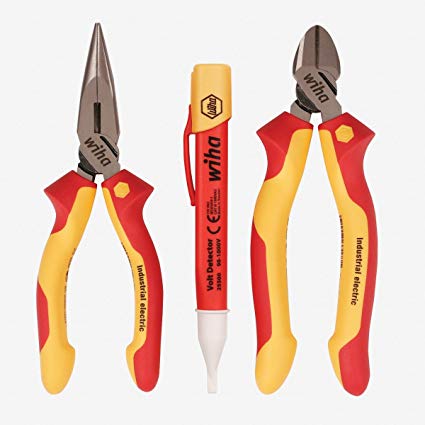Three Piece Professional Electricians Insulated Set includes: 6.3″ Diagonal Cutters 6.3″ Long Nose Pliers Voltage Detector with both light and sound alerts Diagonal Cutters: Up to AWG #6 Low wear lap joint, riveted and able to withstand high levels of load. Lightweight action, clean cutting. Long term cutting is achieved through additional inductive hardening to approx. 60 HRC Special tool steel hardened and tempered Industrial brushed finish For soft, medium hard, and piano wire New Dynamic Joint Provides 40% Easier Cuts and Significantly Longer Tool Life Long Nose Pliers (with cutters): Up to AWG #10 Drop-forged from special tool steel Cutters additionally induction hardened (approx. 60 HRC) Half-round jaws Serrated gripping surface Industrial brushed finish Ergonomic comfort grip with slip guard Voltage Detector: The Wiha Volt Detector is both handy and easy to use. The integrated LED in the plastic tip illuminates red and emits audible warning as soon as AC voltage is detected. For this, the volt detector is simply held adjacent to any terminal or led along an isolated cable using the plastic tip. The LED and audible warning are triggered when the volt detector identifies a live energized wire through the insulation. The measuring sensor ensures particularly safe work. It detects AC voltages between 90 and 1000 volts with the precise proximity sensor. At just 2 oz, it is very lightweight. The device is powered by two AAA batteries, which can be replaced quickly and easily: simply press the middle of the clip, pull back the yellow cap, replace the batteries and replace the cap. The Wiha Volt Detector is tested in accordance with applicable standards. For safe use always check the detector by first testing on a known live energized insulated cable to verify function and working battery levels. According to the Electrical Safety Foundation (ESFI) more than 30,000 Americans experience electrical shock injuries annually. Don’t be a stati
Hand Tools / Power & Hand Tools / Tools & Home Improvement / Wiha

